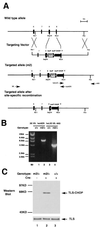Induction of a secreted protein by the myxoid liposarcoma oncogene
- PMID: 10220412
- PMCID: PMC21810
- DOI: 10.1073/pnas.96.9.5025
Induction of a secreted protein by the myxoid liposarcoma oncogene
Abstract
The TLS-CHOP oncoprotein, found in the majority of human myxoid liposarcomas, consists of a fusion between the transcription factor CHOP/GADD153 and the N terminus of an RNA-binding protein TLS/FUS. Clinical correlation and in vitro transformation assays indicate that the N terminus of TLS plays an important role in oncogenesis by TLS-CHOP. Until now, however, the only activity attributed to the oncoprotein is that of inhibiting the binding of transcription factors of the C/EBP class to certain adipogenic target genes, a function that TLS-CHOP shares with the nononcogenic CHOP protein. Here we report the isolation of a gene, DOL54, that is activated in primary fibroblasts by the expression of TLS-CHOP. DOL54 is expressed in the neoplastic component of human myxoid liposarcomas and increases the tumorigenicity of cells injected in nude mice. Activation of DOL54 requires an intact DNA-binding and dimerization domain in TLS-CHOP, a suitable cellular dimerization partner, and depends on the TLS N terminus. Normal adipocytic differentiation is associated with an early and transient expression of DOL54, and the gene encodes a secreted protein that is tightly associated with the cell surface or extracellular matrix. TLS-CHOP thus leads to the unscheduled expression of a gene that is normally associated with adipocytic differentiation.
Figures





Similar articles
-
TLS-CHOP target gene DOL54 expression in liposarcomas and malignant fibrous histiocytomas.Pathol Int. 2002 Aug;52(8):497-500. doi: 10.1046/j.1440-1827.2002.01391.x. Pathol Int. 2002. PMID: 12366807
-
Oncogenic transformation and inhibition of adipocytic conversion of preadipocytes by TLS/FUS-CHOP type II chimeric protein.Am J Pathol. 1997 Sep;151(3):735-44. Am J Pathol. 1997. PMID: 9284822 Free PMC article.
-
Chimeric TLS/FUS-CHOP gene expression and the heterogeneity of its junction in human myxoid and round cell liposarcoma.Am J Pathol. 1995 Nov;147(5):1221-7. Am J Pathol. 1995. PMID: 7485386 Free PMC article.
-
TLS-CHOP and the role of RNA-binding proteins in oncogenic transformation.Curr Top Microbiol Immunol. 1997;220:131-42. doi: 10.1007/978-3-642-60479-9_8. Curr Top Microbiol Immunol. 1997. PMID: 9103679 Review. No abstract available.
-
Updates on the cytogenetics and molecular genetics of bone and soft tissue tumors: liposarcoma.Cancer Genet Cytogenet. 2004 Nov;155(1):1-24. doi: 10.1016/j.cancergencyto.2004.08.005. Cancer Genet Cytogenet. 2004. PMID: 15527898 Review. No abstract available.
Cited by
-
Suppression of MKL1 promotes adipocytic differentiation and reduces the proliferation of myxoid liposarcoma cells.Oncol Lett. 2020 Dec;20(6):369. doi: 10.3892/ol.2020.12232. Epub 2020 Oct 19. Oncol Lett. 2020. PMID: 33154767 Free PMC article.
-
Male sterility and enhanced radiation sensitivity in TLS(-/-) mice.EMBO J. 2000 Feb 1;19(3):453-62. doi: 10.1093/emboj/19.3.453. EMBO J. 2000. PMID: 10654943 Free PMC article.
-
Suppression of antitumor cytokine IL‑24 by PRG4 and PAI‑1 may promote myxoid liposarcoma cell survival.Biomed Rep. 2023 Jul 26;19(3):60. doi: 10.3892/br.2023.1642. eCollection 2023 Sep. Biomed Rep. 2023. PMID: 37614985 Free PMC article.
-
Biochemical Properties and Biological Functions of FET Proteins.Annu Rev Biochem. 2015;84:355-79. doi: 10.1146/annurev-biochem-060614-034325. Epub 2014 Dec 8. Annu Rev Biochem. 2015. PMID: 25494299 Free PMC article. Review.
-
Human synovial lubricin expresses sialyl Lewis x determinant and has L-selectin ligand activity.J Biol Chem. 2012 Oct 19;287(43):35922-33. doi: 10.1074/jbc.M112.363119. Epub 2012 Aug 28. J Biol Chem. 2012. PMID: 22930755 Free PMC article. Clinical Trial.
References
-
- Sreekantiaiah S, Karakousis C P, Leong S P L, Sandberg A A. Cancer. 1992;69:2484–2495. - PubMed
-
- Åman P, Ron D, Mandahl N, Fioretos T, Heim S, Arhenden K, Willén H, Rydholm A, Mitelman F. Genes Chromosomes Cancer. 1992;5:271–277. - PubMed
-
- Knight J C, Renwick P J, Dal Cin P, Van Den Berghe H, Fletcher C D M. Cancer Res. 1995;55:24–27. - PubMed
-
- Panagopoulos I, Höglund M, Mertens F, Mandahl F, Mitelman F, Åman P. Oncogene. 1995;11:1133–1137. - PubMed
-
- Dal Cin P, Sciot R, Panagopoulos I, Aman P, Samson I, Mandahl N, Mitelman F, Van den Berghe H, Fletcher C D. J Pathol. 1997;182:437–441. - PubMed
Publication types
MeSH terms
Substances
Associated data
- Actions
Grants and funding
LinkOut - more resources
Full Text Sources
Molecular Biology Databases
Research Materials

